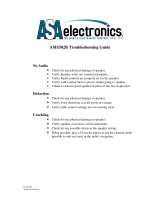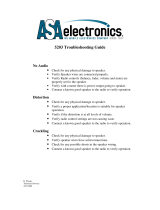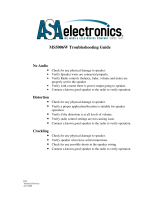Page is loading ...

Owner’s manual & Installation manual
Mode d’emploi et manuel d’installation
Manual de instrucciones y de instalación
XC AMPLIFIERS
AMPLIFICATEURS XC
AMPLIFICADORES XC
XC 2510
XC 2410
XC 2110
12/30/2014

English
XC2510/XC2410/XC21102
Thank you for purchasing this Clarion product.
• Please read this owner’s manual in its entirety before operating this equipment.
• After reading this manual, keep it handy, such as in your glove compartment.
• Save your sales receipt. The warranty at the end of this manual and your sales
receipt are essential for warranty service.
FCC Approval
This equipment has been tested and found to comply with the limits for a Class
B digital device, pursuant to Part 15 of the FCC Rules. These limits are designed
to provide reasonable protection against harmful interference in a residential
installation. This equipment generates, uses, and can radiate radio frequency
energy and, if not installed and used in accordance with the instructions, may cause
harmful interference to radio communications. However, there is no guarantee that
interference will not occur in a particular installation. If this equipment does cause
harmful interference to radio or television reception, which can be determined by
turning the equipment off and on, the user is encouraged to consult the dealer or an
experienced radio/TV technician for help.
CLARION PRODUCT REGISTRATION INFORMATION
For USA and Canada only
www.clarion.com
Dear Customer:
Congratulations on your purchase of a Clarion mobile electronic product. We are
website at www.clarion.com to register your Clarion product.
We have made product registration simple with our easy to use website. The
registration form is short and easy to complete. Once you’re registered, we can keep
you informed of important product information.
Register at www.clarion.com - it’s easy to keep your Clarion product up to date.

English
XC2510/XC2410/XC2110 3
Contents
1. FEATURES .................................................... 4
2. PRECAUTIONS ................................................ 5
Installation ..................................................... 5
3. CONTROLS ................................................... 6
4. OPERATIONS.................................................. 8
Setting the operating level......................................... 8
Improving bass sound ............................................ 8
Designing a more advanced system................................. 8
Connecting a source unit without RCA outputs......................... 8
Care and maintenance ........................................... 9
5. INSTALLATION AND WIRING..................................... 9
What is included in the box ........................................ 9
Mounting precautions ............................................ 9
Wiring precautions............................................... 10
Power and speaker connections .................................... 11
Applications .................................................... 12
Setting the gain ................................................. 14
Setting the crossover............................................. 15
Setting the bass boost ........................................... 15
Final system checks ............................................. 15
6. TROUBLESHOOTING ........................................... 16
7. GLOSSARY.................................................... 17
8. SPECIFICATIONS .............................................. 17
9. LIMITED WARRANTY INFORMATION .............................. 19
Manuel de L'utilisateur (French)................................... 20
Manual del Propietario (Spanish) .................................. 38

English
XC2510/XC2410/XC21104
The Clarion XC2510, XC2410, and XC2110 amplifiers fit a variety of system
configurations and provide these features:
• Full frequency response with low distortion and exceptional signal-to-noise
performance.
• Advanced circuitry design provides bridgeable outputs for use in a variety of
applications.
• Independent electronic crossovers, each with a 12dB per octave slope and full
adjustment range (from 35Hz to 250Hz) to aid in audio system design.
• Bass boost circuit to reinforce low frequency signals that may be lost due to
subwoofer box design.
• Adjustable input level controls with ground loop isolation to accept a wide range of
input signals.
• Remote turn-on with “soft start” muting to prevent turn-on “thump”.
• Protection circuits for overheating and speaker shorts.
• 2-Ohm load capable of driving a variety of speaker systems.
• Niclel-plated input/output connectors and an on-board ATC-type fuse.
• Nickel heat sink for efficient heat dissipation.
• Low profile, compact footprint to accommodate space limitations.
1. FEATURES

English
XC2510/XC2410/XC2110 5
• Do not operate this product in ways other than those described in this manual.
• Do not disassemble or modify this product.
• Do not pour liquid or poke foreign objects into the unit. Water and humidity will
damage internal circuitry.
• If the unit becomes wet, turn off all power and ask your authorized Clarion dealer
to clean or service the unit.
Failure to observe these precautions may damage your car or the amplifier, and may
void the warranty.
WARNING!
Exposure to continuous sound levels of 85dB or higher may
result in hearing loss. Although Clarion products are capable
of producing high sound pressure levels, please use your
product at reasonable levels.
While operating your vehicle, please observe all local sound
ordinances for your safety.
Installation
Installation of mobile audio and video components requires experience with a
variety of mechanical and electrical procedures. Although this manual provides
general installation and operation instructions, it does not show the exact installation
methods for your particular application.
If you do not have the required knowledge and experience to successfully complete
the installation, consult an authorized Clarion dealer about professional installation
options.
2. PRECAUTIONS

English
XC2510/XC2410/XC21106
XC2510 controls and input connections
3. CONTROLS
White (+)
White/Black (-)
CH1 (White)
Front Left
CH2 (Red)
Front Right
CH3 (White)
Rear Left
Front Line Input
Gray
Black
Purple
Rear Line Input
SUB Line Input
CH4 (Red)
Rear Right
SUB (White)
Left
SUB (Red)
Right
Gray (+)
Gray/Black (-)
Green (+)
Green/Black (-)
Purple (+)
Purple/Black (-)
FR Left (CH1)
FR Right (CH2)
RR Right (CH4)
RR Left (CH3)
5 6
1
1 2
3 4
3 4 5 6
7 8 9
12
2
12
XC2410 controls and input connections
CH1 (White)
Front Left
CH2 (Red)
Front Right
CH3 (White)
Rear Left
Black
Gray
Front Line Input
Rear Line Input
CH4 (Red)
Rear Right
White (+)
White/Black (-)
Gray (+)
Gray/Black (-)
Green (+)
Green/Black (-)
Purple (+)
Purple/Black (-)
FR Left (CH1)
FR Right (CH2)
RR Right (CH4)
RR Left (CH3)

English
XC2510/XC2410/XC2110 7
3. CONTROLS
XC2110 controls and input connections
Left (White)
Right (Red)
White (+)
White/Black (-)
Gray (+)
Gray/Black (-)
Left
Right
10
9
11
1 2
12
1. HI Input connection cables for CH1
(Front LT), CH2 (Front RT), CH3 (Rear
LT), CH4 (Rear RT)
2. LOW Input RCA jacks for CH1 (Front
LT), CH2 (Front RT), CH3 (Rear LT),
CH4 (Rear RT), Subwoofer
3. Front gain control
4. Front Hi-Pass X-Over control
5. Rear gain control
6. Rear Hi-Pass X-Over control
7. Subwoofer gain control
8. Subwoofer Low-Pass X-Over control
9. Bass Boost control
10. Gain control
11. Low-Pass X-Over control
12. Status indicator light

English
XC2510/XC2410/XC21108
Setting the operating level
The gain controls allow you to set the nominal operating level of the amplifier from
200mV to 8V for RCA inputs or 600mV to 20V for speaker level inputs. This wide
adjustment range accommodates virtually any source unit brand.
Improving bass sound
The amplifiers feature a narrow-frequency band bass boost circuit (known as
“high-Q”). The bass boost control acts much like an equalizer with switchable gain
fixed at 50Hz.
Use this control to tune low-frequency audio response to compensate for a less than
ideal subwoofer enclosure design. The added boost produces rich, full bass tones
that are normally difficult to reproduce in the car audio environment.
Note:
If you don’t want to boost the bass frequencies, set this control to minimum.
Designing a more advanced system
Freq (Hz) controls
The high pass crossover frequency is fully adjustable between 35Hz and 250Hz
(35Hz-250Hz on the low-pass crossover XC2110). Use the high-pass/low-pass filter
controls, along with your speaker manufacturer’s recommended crossover frequencies,
to quickly design a more advanced system.
X-Over mode switches
These switches are equipped with 12dB per octave electronic filters for precise
frequency attenuation with minimal phase distortion.
Connecting a source unit without RCA outputs
The speaker level inputs provide connections for a high-level stereo source. Use
them if your source unit does not have RCA outputs.
4. OPERATIONS

English
XC2510/XC2410/XC2110 9
Care and maintenance
Cleaning the product
Use a soft, dry cloth to gently wipe dust and dirt from the unit.
Do not use window cleaners, household cleaners, aerosol sprays, solvents, alcohol,
ammonia, or other cleaners. These substances may damage the unit.
Servicing the product
In the event that trouble arises, never open the case or disassemble the unit. The
internal parts are not serviceable by the user. Opening any components will void the
warranty.
Read these instructions and the following precautions carefully.
What is included in the box
In addition to this manual, the box contains:
• Amplifier
• (4) Self tapping screws
• (4) Washers
Mounting precautions
If you lack the necessary skills, do not install the amplifier yourself.
See your authorized Clarion dealer for installation recommendations.
• This unit is exclusively for applications with a negative ground, 12V power supply.
• This unit requires additional mobile audio components for proper operation.
• Choose a location in the application that provides adequate ventilation around the
amplifier. Although any moving air dissipates heat, cool air should run along the
length of the fins rather than across them.
5. INSTALLATION AND WIRING
CAUTION!
Changes or modifications to this product not approved by the
manufacturer will void the warranty and will violate FCC approval.
CAUTION!
Although Clarion amplifiers include heat sinks and protection
circuits, mounting an amplifier in a tight space without any air
movement will damage the unit’s internal circuitry over time.

English
XC2510/XC2410/XC211010
• Mount the amplifier on a rigid surface away from subwoofer enclosures or to any
area that is prone to vibration. Do not install the amplifier on plastic or on any
other combustible material.
• For easy system setup, mount the amplifier so that the panel controls are
accessible after installation.
• Always use great care when attaching anything to a surface! Check clearances on
all sides of the planned installation before drilling any holes or installing any
screws.
• Make sure the holes you drill will not cut into the fuel tank, fuel lines, hydraulic lines
(under the chassis) or electrical wiring.
Wiring precautions
Read all wiring precautions. If you are not sure of the connections, contact your
authorized Clarion dealer.
• Before you start, make sure the source unit’s power switch is off.
WARNING!
To prevent short circuits during installation, disconnect the
vehicle’s negative (-) battery lead before making any power
connections.
• Extra cable can cause signal loss and act as an antenna for noise. Use only
high quality RCA cables that are no longer than necessary to make a direct
connection with the source unit and amplifiers.
• Make sure each connection is clean and secure. Insulate final connections with
electrical tape
or shrink tubing.
CAUTION!
Improper connections may damage the equipment.
• When routing RCA cables, keep the cables away from the power cables and out
put speaker wires.
• A good chassis ground connection is critical to minimize resistance and avoid
noise problems. Use the shortest wire possible. Clean off any paint prior to making
connections. Securely connect the ground wire to the chassis and the source
unit ground.
• Add an external fuse to the amp’s positive (+) power lead and connect it as close
as possible to the vehicle’s plus (+) battery terminal. Use a fuse rated to the total
current consumption of the amplifier. Adding an external fuse protects the
electrical system from short circuits that can result in a fire.
• Do not open the case. There are no user-serviceable parts inside. If you require
assistance, consult your Clarion dealer or an authorized Clarion service center.

English
XC2510/XC2410/XC2110 11
Power and speaker connections
XC2510
Power connector
Ground (-)
Battery (+12V)
Battery (+12V)
Ground (-)
Speaker output
Front Left (CH1)
Front Right (CH2)
Rear Left (CH3)
Rear Right (CH4)
Subwoofer (CH5)
Amplifier Turn On
Speaker output
Front Left (CH1)
Front Right (CH2)
Rear Left (CH3)
Rear Right (CH4)
Amplifier Turn On
Speaker output
Subwoofer
Amplifier Turn On
XC2410
Power connector
Battery (+12V)
Ground (-)
XC2110
Power connector
Battery (+12V)
Ground (-)
Fuse 40A
Speaker
Output
Fuse 40A
Fuse 40A
Power Input
Speaker
Output
Speaker
Output
Power Input
Power Input

English
XC2510/XC2410/XC211012
Applications
Mono subwoofer system
This application shows the amplifier in mono operation to drive a subwoofer.
Left (White)
Right (Red)
Subwoofer

English
on Bridge Mode.
XC2510/XC2410/XC2110
13
Four-channel stereo system
In this application, the XC2410 is used as a four-channel amplifier to
drive four full-range speakers in stereo.
CH1 Front Left CH4 Rear Right
CH3 Rear Left
White/Black
White
Purple/Black
Purple
Green/Black
Green
Gray/Black
Gray
CH2 Front Right
Bridged #1
White
Purple/Black
(+) Green
Gray/Black
//
//
\\
\\
Bridged #2
Each bridged channel of the XC2410 can
drive one (1) full-range 4-ohm speaker.
(+)
(
-
)
(
-
)
Bridged Power Output
Refer to the Specifications in Section 8 (Pg. 17) of the manual for additional information
Bridged Mode
In this application, the XC2410 can be wired
for Bridge Mode

CH4
RR Right
CH3
RR Left
Purple/Black
Purple
Green/Black
Green
English
XC2510/XC2410/XC211014
Single amplifier combination system
In this application, the XC2510 is used to drive a full system.
Purple
Yellow/Black
Black
Subwoofer
CH1
FR Left
White/Black
White
Gray/Black
Gray
CH2
FR Right
Gray Black
Purple/Black
Green
Yellow/Black
White
Gray/Black
Bridged #1
Bridged #2
\\
\\
\\
\\
(+)
(+)
(
-
)
(
-
)
Black
(
-
)
(+)
Subwoofer
Each bridged channel of the XC2510 Amplifier can
drive one (1) full-range 4-ohm speaker.
Setting the gain
After completing the installation, follow these steps to set the
gain control and perform the final system checks.
1. Turn the gain control all the way counterclockwise.
2. Turn the ignition switch on.
Bridged Power Output
Refer to the Specifications in Section 8 (Pg.17) of the
manual for additional information on Bridge Mode.
Bridged Mode
In this application, the XC2510 can be wired
for Bridge Mode.

3. Turn the source unit on.
3. Turn the source unit on.
4. Set all tone or equalization controls to flat positions and turn loudness off.
5. Play music content and set the volume control to 75% of full level.
Note:
If the system uses an equalizer, set all frequency controls to the flat
position.
6. Slowly increase the gain control. Stop when you hear a slight audio distortion.
English
XC2510/XC2410/XC2110 15
Setting the crossover
Clarion amplifiers feature fully-adjustable crossovers.
1. The XC2410 is equipped with high-pass crossovers, the XC2110 is equipped with
low-pass crossovers, and the XC2510 is equipped with high-pass crossovers on
channels 1-4, and low-pass crossover on channel 5.
2. Using the Freq (Hz) control, select the frequency.
Setting the bass boost
1. Initially set the bass boost control to off.
2. Listen to a variety of music styles (for example, rock, rap, etc.) and switch the
bass boost control on until you notice an increase in low bass response.
CAUTION!
If you hear a pop caused by speaker overexertion, lower the
bass boost to prevent damage to the speaker.
Final system checks
1. Start the engine and turn on the source unit. (Please make sure vehicle is
outdoors or has adequate ventilation for exhaust fumes)
2. After a two-second delay, slowly increase the volume control and listen to the
audio.
If you hear any noise, static, distortion or no sound at all, check the connections
and refer to Troubleshooting. Depending on your system, the volume may become
quite loud even at low level settings. Until you get an “audio feel” for the system’s
power, use care when adjusting the controls.
3. Turn the balance controls to their extreme positions and listen to the results. Audio
output should match control settings (audio from the left speaker when balance is
left).
4. Increase the volume and verify that the amplifier reproduces
the audio at full
frequencies without distortion.
If you hear distortion check the connections and verify that the gain control is set
correctly. Another cause of distortion could be underpowered or damaged
speakers. Refer to Troubleshooting.

English
XC2510/XC2410/XC211016
No Audio
• Low or no remote turn-on voltage: check remote connections at the amplifier and
source unit.
• Blown amplifier fuse: replace with a new fast-blow fuse (same rating).
• Power wires not connected: check battery and ground wiring at the amplifier and
check the battery connections.
• Speaker leads shorted: check speaker continuity to ground; it should not show a
common ground.
• Speakers not connected or are blown: check speaker connections at the
amplifier; measure coil impedance.
Audio cycles on and off
• Thermal protection circuits are shutting the amplifier off.
• Check the location for adequate ventilation. Consult an authorized Clarion audio
dealer.
Distorted audio
• Gain is not properly set or the speaker cones are damaged.
• Review the instructions for setting the gain. Inspect each speaker cone for signs
of damage, such as a frozen cone, burning smell, etc.
Amplifier fuse keeps blowing
• The wiring is connected incorrectly or there is a short circuit.
• Review the installation precautions and diagram in this manual and check all
wiring connections.
Whining or ticking noise when engine on
• The amplifier is picking up alternator or radiated noise.
• Turn down input gain.
•
Move the audio cables away from the power wires.
• Check the power and ground connections on the amplifier and install an in-line
noise filter on the source unit’s power wire.
• Check the alternator and/or voltage regulator. Test for a weak battery or add
water to the battery.
6. TROUBLESHOOTING

C
M
Y
CM
MY
CY
CMY
K
page 17_18.pdf 1 2/26/2015 7:52:23 AM

C
M
Y
CM
MY
CY
CMY
K
page 17_18.pdf 2 2/26/2015 7:52:23 AM

C
M
Y
CM
MY
CY
CMY
K
page 19.pdf 1 2/26/2015 7:53:32 AM

C
M
Y
CM
MY
CY
CMY
K
page 20.pdf 1 2/26/2015 7:55:40 AM
/


